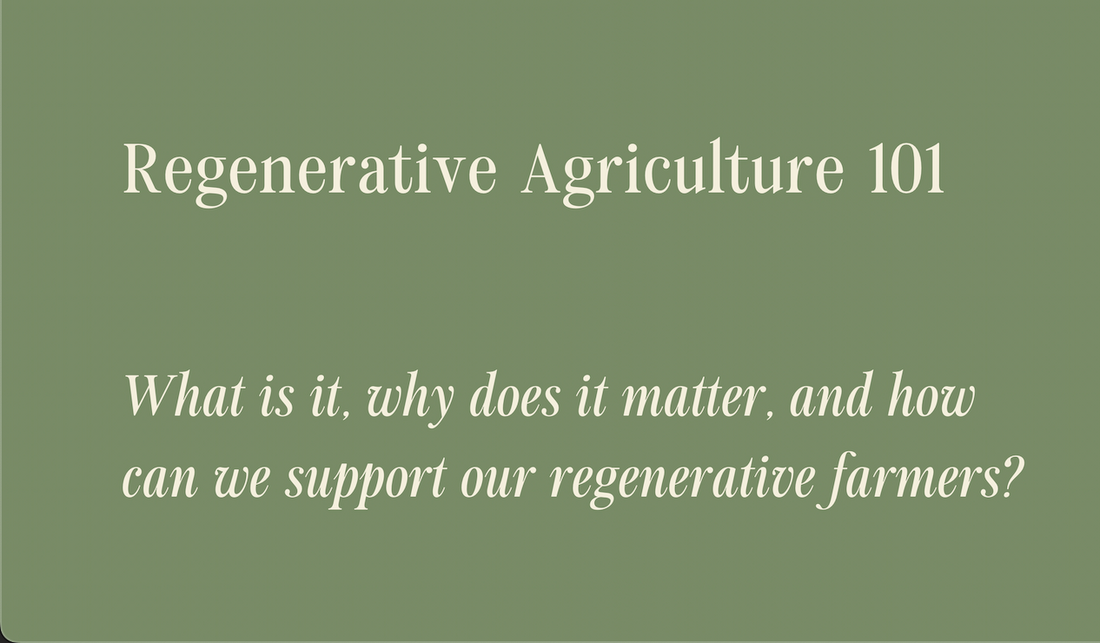What is it, why does it matter, and how can we support our regenerative farmers?
Regenerative agriculture is a term used to encompass a variety of farming practices that can be used to improve, regenerate, and protect ecological health. These practices vary depending upon the climate and context of the land. Examples include use of managed grazing practices, minimal tillage, livestock organic fertilizer, cover crops, minimal use of inorganic chemicals, and crop rotations.
Why Regenerative?
Farming has many outputs beyond the food on your table. Everything from our water quality to potential use of that land in the future are affected. Regenerative agriculture encourages farming in a way that creates prosperous land for both the present and the future. These practices work to improve soil quality and health over time. Land becomes more resilient against wind, droughts, and floods as thicker topsoil layers and cover crops protect the soil. Soil holds onto moisture and nutrients better, meaning farmers require less spend on water irrigation and fertilizers. Farmers also save spending on chemical treatments such as pesticides, and less water runoff means there is less farm waste leeching into our water systems.
All About Topsoil
Topsoil is the upper most layer of soil that contains the vast majority of nutrients needed for plants to grow, meaning that without it, crops have no foundation to grow from. According to the Smithsonian, more than 50 million tons of topsoil have eroded in the Midwest as of 2023. This is a cause of concern since recovering topsoil is a slow process that takes years; generating one inch of topsoil may take 1,000 years or more.
Room For Improvement
According to USDA, no-till practices have already been implemented by 51 percent of US farmers, while cover crops are used on about 7.5 percent of US farmland acres - a near 50 percent increase in cover crop adoption in the last 5 years.
By contrast, the industrial agricultural system that dominates the US food supply focuses on individual crop yield and short term gains, incentivizing practices that promote soil erosion at a rate of 10 to 100 times higher than soil formation. Consequences of this may include nutrient runoff, harmful algal blooms in freshwater and coastal systems, land erosion, and threats to local biodiversity, including critical pollinators.
Playing the Long Game
A 2023 article by the Texas Tribune illustrates how more farmers are turning to regenerative practices with the goal of creating change for the long term. Katie Lewis, a soil scientist for Texas A&M AgriLife in Lubbock, said she saw an increase in farmers turning to these practices last year following the failure of cotton harvests due to dry weather: “That was a really good indicator that they (farmers) want to improve the overall health of their soil and get to a point where they can start implementing these practices. It’s all about farmers figuring out what works best for them and their farms.”
-
Perhaps the biggest challenge in switching to a regenerative farm is the amount of time it can take to yield results. It can take anywhere from five to ten-plus years to see a farm flourish after switching to regenerative agriculture. However, the long term cost savings, yields, protection of biodiversity, and preservation of land seem to be the incentive for farmers to start implementing these practices for the benefit of future generations.
No Supply Without Demand
Reuters estimates that, of the 900 million arable acres in the US, only 1.5 percent is being farmed regeneratively. Unfortunately for our farmers, there aren’t any government incentives to encourage the switch from industrial to regenerative practices. Moreover, for those working to feed their families and put food on the table, it is understandable why farmers may be apprehensive to shifting their ways of working (for example, omitting pesticide use) and perhaps risk losing some short term gains. However, consumer demand for regenerative agriculture products seems to be increasing, with more and more regenerative products coming to the market.
How can you help?
Where you put your money matters. Buying products that are sourced using regenerative agriculture practices is probably the most effective way to directly support these farmers. This goes beyond food purchases - regenerative agriculture is finding its way into bath and beauty products, candles, towels and blankets, and beverages like coffee and wine. For example, Recaredo wines in Barcelona is a company working preserve quality, tradition, and their environment. Their classic wine harvesting methods forego the use of modern chemicals, instead using methods such as cover cropping to protect the soil and keep out unwanted pests.

Some Aware House featured items that implement these practices are from Summer Solace Tallow and Little Seed Farm - both companies source their components from organic pasture raised cattle and goats and are vocal about how regenerative practices are fundamental aspect to their companies.
Check out our AH list for more recommendations on companies that are incorporating these types of practices into their sourcing and production and let us know if you have any additions for our list.
Finally, make sure to always support your local farmers whenever you can!





